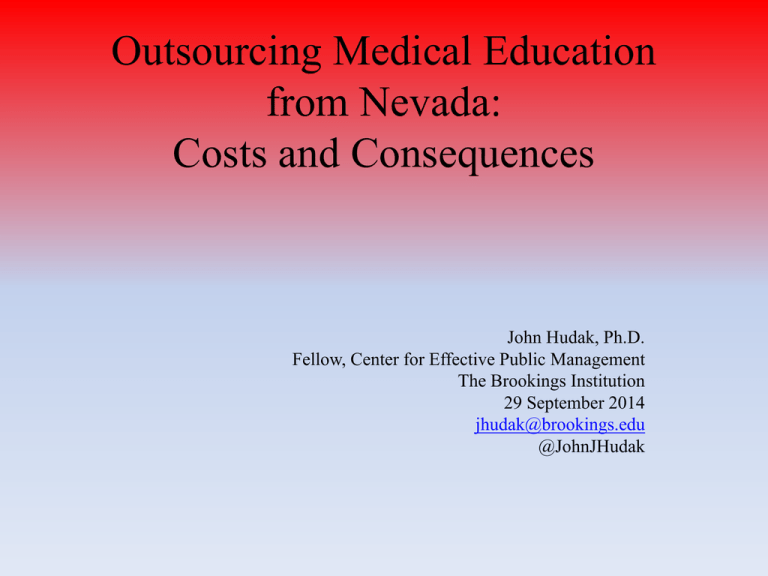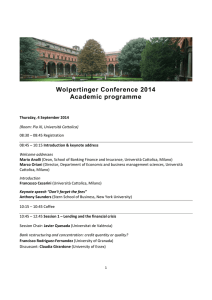
Outsourcing Medical Education
from Nevada:
Costs and Consequences
John Hudak, Ph.D.
Fellow, Center for Effective Public Management
The Brookings Institution
29 September 2014
jhudak@brookings.edu
@JohnJHudak
Requirements Outsourcing
• A product of value
• A geographic transfer
– Location of origination
– Destination
• A cost to location of origination/benefit for
destination
Outsourcing & Medical Education
•
•
•
•
Every state has healthcare needs
Every state has medical training opportunities
Every state has addition training capacity
Supply & demand of medical professionals
– Surplus of medical professionals
– Shortage of medical professions
• Results: importing or exporting of medical
professionals
Outline
Part I. A Geographic Basis for a New Medical School
Part II. A Healthcare Basis for a New Medical School
Part III. A Funding Basis for a New Medical School
Part IV. Conclusions
A Geographic Basis for
a New Medical School
Distribution of Allopathic Medical Schools among the 50 States
0 Medical Schools
1 Medical School
2 Medical Schools
3 Medical Schools
4 Medical Schools
5+ Medical Schools
A Geographic Basis for
a New Medical School
Location of Allopathic Medical Schools in the U.S.
A Geographic Basis for
a New Medical School
Top 50 Metropolitan Statistical Areas (MSA) With(out) Allopathic Medical Schools
MSA with a Medical School
MSA with a Medical School Branch
MSA with a Medical School Set to Open
MSA without a Medical School
A Geographic Basis for
a New Medical School
Top 50 Combined Statistical Areas (CSA) With(out) Allopathic Medical Schools
CSA with a Medical School
CSA with a Medical School Branch
CSA without a Medical School
A Geographic Basis for
a New Medical School
A Geographic Basis for
a New Medical School
A Geographic Basis for
a New Medical School
Top 100 Largest Metropolitan Statistical Areas without an
Allopathic Medical School
Population
Rank
83
100
31
70
56
81
99
53
91
62
55
65
64
69
35
23
98
Metropolitan
Statistical Areas
Boise, ID
Spokane, WA
Las Vegas, NV
McAllen, TX
Fresno, CA
Ft. Myers, FL
Chattanooga, TN
Phoenix, AZ
Des Moines, IA
Bakersfied, CA
Tulsa, OK
Greenville, SC
Knoxville, TN
Baton Rouge, LA
Austin, TX
Charlotte, NC
Melbourne, FL
Nearest Medical
School
Salt Lake City, UT
Seattle, WA
Loma Linda, CA
San Antonio, TX
Palo Alto, CA
Miami, FL
Atlanta, GA
Tucson, AZ
Iowa City,l IA
Los Angeles, CA
Oklahoma City, OK
Columbia, SC
Johnson City, TN
New Orleans, LA
San Antonio, TX
Winston-Salem, NC
Orlando, FL
Distance
340
279
232
228
168
126
118
116
114
112
106
103
101
81
80
78
73
Population
Rank
40
79
97
68
90
52
78
74
94
66
88
87
86
73
57
34
Metropolitan
Statistical Areas
Jacksonville, FL
Colorado Springs, CO
Youngstown, OH
Allentown, PA
Daytona Beach, FL
Grand Rapids, MI
Stockton, CA
Sarasota, FL
Provo, UT
Thousand Oaks, CA
Ogden, UT
Lakeland,lFL
Springfied, M
A
Greensboro, NC
Bridgeport, CT
San Jose, CA
Nearest Medical
School
Gainesville, FL
Denver, CO
Pittsburgh, PA
Philadelphia, PA
Orlando, FL
Kalamazoo, MI
Sacramento, CA
Tampa, FL
Salt Lake City, UT
Los Anegeles, CA
Salt Lake City, UT
Tampa, FL
Farmington, CT
Winston-Salem, NC
New Haven, CT
Palo Alto, CA
Distance
72
68
67
62
57
51
49
46
45
40
38
35
34
29
20
17
Note: MSA drawn from Census Bureau, MSA population data in 2012. Distance between medical schools calculated as driving distance.
Yellow highlighting denotes a city with a branch campus of an allopathic medical school.
A Geographic Basis for
a New Medical School
Allopathic Medical Schools Founded 2000-2013
Medical School
Year of
Founding
Central Michigan University College of Medicine
Western Michigan University Homer Stryker School of Medicine
Oakland University William Beaumont School of Medicine (MI)
Frank Netter School of Medicine at Quinnipiac University (CT)
Florida Atlantic University Charles Schmidt College of Medicine
Hostra University North Shore-LIJ School of Medicine (NY)
Virginia Tech Carilion School of Medicine
The Commonwealth Medical College (PA)
University of California-Riverside School of Medicine
2013
2012
2011
2010
2010
2010
2010
2008
2008
Texas Tech Univ. Health Sciences Center Paul Foster School of Medicine
2008
Florida International University Herbert Wertheim College of Medicine
University of Central Florida College of Medicine
Cleveland Clinic Lerner College of Medicine
Florida State University College of Medicine
2006
2006
2002
2000
A Geographic Basis for
a New Medical School
Distance between New & Existing Medical Schools
New Medical School
Central Michigan University College of Medicine
Western Michigan University Homer Stryker School of Medicine
Oakland University William Beaumont School of Medicine
Frank Netter School of Medicine at Quinnipiac University (CT)
Florida Atlantic University Charles Schmidt College of Medicine
Hostra University North Shore-LIJ School of Medicine
Virginia Tech Carilion School of Medicine
The Commonwealth Medical College (PA)
Univ. of California-Riverside School of Medicine
Texas Tech University Health Sciences Center Paul Foster School
of Medicine
Florida International Univ.Herbert Wertheim College of
Medicine
University of Central Florida College of Medicine
Cleveland Clinic Lerner College of Medicine
Florida State University College of Medicine
Year of Nearest Existing
Founding Medical School
2013
2012
2011
2010
2010
2010
2010
2008
2008
Distance
2008
Michigan State University
Michigan State University
Wayne State University
Yale University
University of Miami
SUNY-Downstate (Brooklyn)
University of Virginia
Penn State
Loma Linda University
Univ. New Mexico/
TX Tech (Lubbock)
68
51
27
9
43
20
121
113
12
272/
344
2006
2006
2002
2000
University of Miami
University of South Florida
Case Western Reserve Univ.
University of Florida
12
85
-149
A Healthcare Basis for
a New Medical School
A shortage of medical professionals in Nevada
•
•
•
•
•
•
•
Family Practice Doctors
Pediatricians
Orthopedic Surgeons
Ophthalmologists
Psychiatrists
OB/GYNs
RNs
47th out of 51 (states + DC)
46th out of 51
51st out of 51
48th out of 51
50th out of 51
40th out of 51
50th out of 51
**Research conducted by University of Nevada School of Medicine, rankings based on
measure of medical professionals per 100,000 residents.
A Healthcare Basis for
a New Medical School
A Shortage of Medical Training in Nevada
• Fewest MD students per 100,000 residents* (Nevada: 9.5 / 100,000;
National Average: 25.8 / 100,000)
• Medical residents/fellows per 100,000 residents, Nevada is 46th.
(Nevada: 8.1 / 100,000; National Average: 25.4 / 100,000)
• Medical residents/fellows per 100,000 residents in primary care roles,
Nevada is 47th. (Nevada 5 / 100,000; National Average: 12.2 / 100,000)
*Ranking based on states with existing allopathic medical schools
Note: All data drawn from 2013 State Physician Workforce Data Book from the
Association of American Medical Colleges (AAMC)
A Healthcare Basis for
a New Medical School
An Opportunity for Nevada Medical Training
Silver State Loyalty in Medical Training
• 69.2% of Nevada residents in MD programs matriculate in state
• Among people who attend medical school & perform residency in NV,
79% stay to practice in state.
– 5th Nationally
– National mean: 66.6%
A Funding Basis for
a New Medical School
Figure 1/2: Fully-Accredited Medical School Revenue by Source
129 Medical Schools, FY2013
All Revenues
4%
Public School Revenues
4%
3%
5%
5%
4%
4%
11%
34%
39%
9%
9%
17%
16%
19%
17%
Median = $521M
Practice Plan
Other Grants & Contracts
Tuition & Fees
Median = $484M
Hospital
Government and Parent Support
Miscellaneous Sources
Source: LCME Part I-A Annual Financial Questionnaire
© Association of American Medical Colleges 2014. All rights reserved.
Federal Grants & Contracts
Gifts & Endowment
A Funding Basis for
a New Medical School
Total State Business Volume Impact of Publicly Funded Resea rch
Conducted at AAMC-Member Institutions Resea rch, 2009
States
State
Rank
Total Economic
Impact
States
State
Rank
Total Economic
Impact
California
1
$ 5,360,125,905
Tennessee
14
$
987,400,090
Massachusetts
2
$ 4,666,938,397
Minnesota
15
$
944,632,296
New York
3
$ 4,532,330,490
Georgia
16
$
936,334,559
Pennsylvania
4
$ 2,892,439,702
Florida
17
$
853,058,512
Texas
5
$ 2,496,576,899
Wisconsin
18
$
801,488,179
North Carolina
6
$ 2,158,422,741
Virginia
19
$
714,777,147
Ohio
7
$ 2,045,422,508
Colorado
20
$
710,221,195
Maryland
8
$ 1,785,291,194
Oregon
21
$
606,657,791
Washington
9
$ 1,777,062,201
Alabama
22
$
597,519,638
Illinois
10
$ 1,599,980,668
District of Columbia
23
$
507,709,004
Missouri
11
$ 1,159,651,627
Rhode Island
24
$
411,336,816
Michigan
12
$ 1,115,569,675
Iowa
25
$
407,826,860
Connecticut
13
$ 1,044,055,338
US Overall
$ 44,947,329,758
Note: Tables include impacts of the 24 individual states and the Di strict of Columbia whe re AAMC members’
impact
c is highest plus an “all other states” total, which reflets the imp act of the remaining 22 states whe re AAMC
members are located. Table drawn from AAMC’s “The Economic Impact of Publicly Funded Research Conducted by
AAMC-Member Medical Schools and Teaching Hospitals” (Nov. 2011)
A Funding Basis for
a New Medical School
Table 3. AAMC Members’ Total Research Employment Impact in FTEs, 2009
States
State Rank
Total Employment Impact
States
State Rank
Total Employment Impact
California
1
35,734
Tennessee
14
6,583
Massachusetts
2
31,113
Minnesota
15
6,298
New York
3
30,216
Georgia
16
6,242
Pennsylvania
4
19,283
Florida
17
5,687
Texas
5
16,644
Wisconsin
18
5,343
North Carolina
6
14,389
Virginia
19
4,765
Ohio
7
13,636
Colorado
20
4,735
Maryland
8
11,902
Oregon
21
4,044
Washington
9
11,847
Alabama
22
3,983
Illinois
10
10,667
District of Columbia
23
3,385
Missouri
11
7,731
Rhode Island
24
2,742
Michigan
12
7,437
Iowa
25
2,719
Connecticut
13
6,960
US Overall
299,649
Note: Table includes impacts of the 24 individual states and the Di strict of Columbia where AAMC
c members’ impact is highest plus an “all other states” total, which reflets
the impact of the remaining 22 states whe re AAMC members are located. Table drawn from AAMC’s “The Economic Impact of Publicly Funded Research Conducted by
AAMC-Member Medical Schools and Teaching Hospitals” (Nov. 2011)
A Funding Basis for
a New Medical School
• GME Funding to the States
– Medicare & Medicaid Programs
– Assistance for Residencies and Fellowships
– Largest Funding Source in US
– Funding Levels Set by Congress
– Bipartisan Reform Bills
• Tuition Dollars (Federal Subsidy)
• Program Plans (Private Sources)
• Philanthropy (Private Sources)
A Funding Basis for
a New Medical School
GME funding per capita, 2005-2009
Year National Average Nevada
Nevada's Rank (out of 46)*
2005
$16.06
$4.03
46
2006
$16.05
$4.65
46
2007
$16.43
$5.77
46
2008
$17.02
$6.96
45 (MS)
2009
$17.94
$8.55
44 (NM, MS)
*Includes the 45 states with allopathic medical schools + DC
Note: Data drawn from the Robert Graham Center [Graham Center Data]
A Funding Basis for
a New Medical School
Results of multivariate analysis of GME
funding among all states
Among all states, every additional medical school graduate =
+$527,000 in additional GME funds
Among all states, adding a medical school = $41.4 million in additional
GME funds
Among all states, data suggests** the addition of a public OR private
medical school is associated with a substantial increase in GME funds
**those results do not achieve statistical significance
A Funding Basis for
a New Medical School
Results of multivariate analysis of GME funding
among states with 3 or fewer medical schools
Every additional medical school graduate is associated with an increase in
additional GME funding, though results do not achieve statistical significance
Every additional medical school = $26.1 million in additional GME funding
Every additional public medical school = $19.8 million in additional GME
funding
Every additional private medical school is associated with an increase in
additional GME funding, though results do not achieve statistical significance
A Funding Basis for
a New Medical School
A Funding Basis for
a New Medical School
Since 2010, NIH funds to new medical schools,
excluding Cleveland Clinic/Lerner School
exceeds $57 million
In 2013:
FAU (2010): $2.25 million
FIU (2006): $3.01 million
FSU (2000): $2.17 million
CMU (2013): $337,431
UCR (2008): $4.40 million
UCF (2006): $5.65 million
Cleveland Clinic/Lerner School (2002): $82.19 million
A Funding Basis for
a New Medical School
A Funding Basis for
a New Medical School
A Funding Basis for
a New Medical School
Additional Types of Funding – HRSA
HRSA Funding per Capita, Mountain West Region
State
Montana
New Mexico
Idaho
Wyoming
Utah
Arizona
Nevada
Grant Dollars per Capita
$139.12
$106.93
$79.55
$54.68
$50.67
$45.09
$24.69
Note: Includes all active grants in FY2014. Data drawn from NHRSA website.
CONCLUSIONS
• Las Vegas among the most isolated cities in the
US for medical training
• Population, healthcare needs, geography,
funding levels all suggest a need for an
allopathic medical school
• Training doctors in Las Vegas may limit
medical brain drain
CONCLUSIONS
• ACA will increase healthcare demand in
Southern NV, an area already facing shortages
• A new medical school can create tremendous
federal, private market, and private charity
opportunities for Las Vegas region
• A new medical school likely increases
research-related private market activity and
FTEs
CONCLUSIONS
• Federal healthcare funding to Nevada is among
the worst in the nation, fitting a trend in federal
funding to the state
• Expanded medical training will increase
opportunities for research funding
• Reform proposals for Medicare GME funding
will help states like Nevada (growing
population, political clout)
THANK YOU


